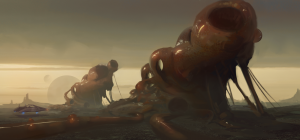 Welcome to the Alternity design blog! Over the next few months we’re going to examine various topics and decision points in the process of building the game. As we noted in our announcement before GenCon, the first step in launching a new Alternity game is to engage the audience (you!) and begin a conversation. We want to give you a chance to “look behind the curtain” and see what kind of design decisions we’re making—and we want to float some trial balloons and see if our potential backers are in favor of our design direction or not.
Welcome to the Alternity design blog! Over the next few months we’re going to examine various topics and decision points in the process of building the game. As we noted in our announcement before GenCon, the first step in launching a new Alternity game is to engage the audience (you!) and begin a conversation. We want to give you a chance to “look behind the curtain” and see what kind of design decisions we’re making—and we want to float some trial balloons and see if our potential backers are in favor of our design direction or not.
So, with all that said, let’s turn to Design Blog Topic #1: Why Alternity?
We have the good fortune of living in something of a science-fiction high-water mark. Every year some of the biggest movie blockbusters are sci-fi stories. Great SF television shows are constantly premiering on cable channels or Netflix series. The sci-fi aisle is one of the biggest and most popular parts of any bookstore. There is a lot of great sci-fi out there for fans like us. But there aren’t many sci-fi RPGs to choose from, and those that are available are tied to very specific settings or feature unique rules systems that make it difficult to create the sci-fi game you want to run at your table.
In short, SF is more popular than ever—and we see a need for a “generic” rules set that lends itself to “hard” sci-fi as opposed to science fantasy or a dedicated SF property. If you like Star Wars, you should play Star Wars. If you like Star Trek, you should play Star Trek (when it comes out). But if you want to build your own world that draws on inspirations from a dozen different sources or tells the stories you want to create, well, we want to give you the rules set to do that.
The seeds for a 2017 Alternity were sown several years ago in a conversation between Bill Slavicsek and Rich Baker, the designers of the original Alternity game. At the time we chose not to move ahead on the idea—Bill’s got a good day job in the computer game biz, and Rich was busy with novels and other Sasquatch projects. (We’re a small outfit at Sasquatch, so we kind of have to do our big efforts one project at a time.) However, after we finished our 5e version of the Primeval Thule setting and got our Ultimate Scheme board game out the door, we decided that it was time to turn to our SF game. The Sasquatches (Rich, Dave, and Steve) began design conversations during the car ride from Indianapolis to Chicago after GenCon 2015, and earlier this summer we called up Bill again to bring him on board as a consultant and contributor.
 Some people in various discussion forums have wondered why we wanted to call the game Alternity if we did not in fact have access to the settings and characters of the previous Alternity game. We think the simplest answer to that question is that we want the 2017 Alternity to fill something very close to the niche held down by the 1996 game: A generic, flexible, fun rules set that covers just about any kind of science fiction subgenre or story you want to play a RPG in. We also want to preserve some of the mechanical “feel” of the old game (remember rolling all the polyhedrals?) while updating the system from a mid-90s design to a mid-10s design. We think we can deliver a great new sci-fi gaming experience next year, and Alternity is the name that best describes that.
Some people in various discussion forums have wondered why we wanted to call the game Alternity if we did not in fact have access to the settings and characters of the previous Alternity game. We think the simplest answer to that question is that we want the 2017 Alternity to fill something very close to the niche held down by the 1996 game: A generic, flexible, fun rules set that covers just about any kind of science fiction subgenre or story you want to play a RPG in. We also want to preserve some of the mechanical “feel” of the old game (remember rolling all the polyhedrals?) while updating the system from a mid-90s design to a mid-10s design. We think we can deliver a great new sci-fi gaming experience next year, and Alternity is the name that best describes that.
Stay tuned over the next couple of months as we roll out additional design blogs and playtest reports, and dive into the nuts and bolts of what we’re doing with the mechanics, the characters, the implicit settings, and the GM tool set. This is a big job and we’re just getting started—we’re looking forward to making you a part of it!

